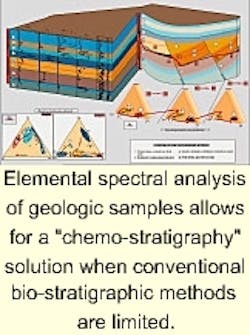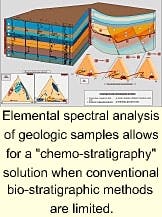From rock cuttings to chemo-stratigraphy
For those who've sat in the logging shack on a rig in the middle of nowhere wondering where you were in a particular stratigraphic column, the following is for you. The days of "logging blind" could be over. A method of performing an inorganic chemical analysis on any given rock sample has been further developed by a UK-based company, called Chemo-Strat.
The technique, used previously in the mining industry, uses inductively coupled plasma (ICP) technology to determine the concentrations of major trace and rare earth elements in cuttings, core, or sidewall core samples. ICP analysis requires that the rock be dissolved into solution with acids and alkalis then submitted to the test equipment for analysis. This entire process can take weeks (sample travel time from rig, complete stratigraphic column samples analyzed, etc.) in some cases. Manipulation and interpretation of these elemental data then allows characterization of geologic sequences geochemically.
A recent advance in laser-induced breakdown spectroscopy (LIBS) has resulted in the development of a better real-time analysis alternative for the oil and gas drilling/exploration industry. The product, called LaserStrat, has lowered this turnaround time to just minutes. Investment by Sperry Sun Drilling Services over the past year has gone to developing a more rig-rugged, PC-sized version of the analysis equipment.
A minimum of 20-25 elements can still be analyzed (with greater accuracy and lower detection limits) within 20 minutes of the cuttings sample reaching the shakers. The closest thing to this kind of real-time elemental analysis performance would be the spectral gamma ray measurement used for years in the electric and while-drilling logging industry. This measurement is a post-well answer product, and usually measures only three elements: thorium, uranium, and potassium.
The high cost and long turnaround time of the current sample analysis equipment/technique has limited its application as a real-time answer tool to a bio-stratigraphy alternative, where limited micro-fossil correlation is available - but greatly needed. This makes the analysis more of a post-well, stratigraphy-defining and confirmation tool.
Using the analysis this way is analogous to the way in-fill seismic information has been used in the past. For example, on numerous projects, the platform is in position and well construction activities are underway while awaiting more detailed seismic interpretations. Though not the optimum way to do business, the best information available at the time was used to spot the platforms and commence well construction activities, but then the burden of optimizing reservoir target penetration is left to the directional drilling service providers.
Again, this is an after-the-fact, on-the-fly correction, demanding that impromptu decisions be made over the course of the field development program. As we all know, hasty impromptu decisions in a business with high financial stakes can be disastrous.
The current analysis technique can take weeks (sample travel time from rig, complete stratigraphic column samples analyzed, etc.) in some cases. The LaserStrat system, on the other hand, uses a laser to ablate the cutting sample into plasma, which is analyzed within minutes. The versatility of the measurement technique allows liquids to be analyzed on the same instrument as solids with minimal re-calibration. Also, analysis is not limited to rock samples.
The system can analyze metal shards within minutes, and provide valuable insight as to the origin of borehole metals. Analyzing miscellaneous debris solids in the return mud could be of great advantage to operators, assessing potential structural damage to in-place well components and/or drilling equipment. The question: "where are the metal shards on the ditch magnets coming from?" is answered in a more timely manner, helping to cut off any detrimental drillstring and/or casing wear before catastrophic failures occur.
The various drilling fluid alternatives currently used in the business do affect the analysis and require a normalization process to a non-indigenous component. Trace element ratios can then be used for analysis and/or correlation purposes. Ignoring certain metals is another useful technique. The spectral nature of the analysis provides flexibility in screening and de-limiting unwanted elements. The current oilfield practice is to set a baseline by analyzing the drilling fluid samples directly, then take those components out of the sample analysis.
The question of cost has to be looked at, beyond the dollar amount. Providers of this new analysis technique anticipate that chemo-stratigraphy will compete with bio-stratigraphy in cost. However, in geologic situations, where availability of bio-stratigraphy data is sparse, chemo-stratigraphy will more than pay for itself in the information gained, whereas bio-stratigraphy would not be as cost effective.
Mud loggers and geologists have often used the spectral capabilities of a gas chromatograph to identify specific gas compositions representative of certain geologic formations, and use that information to correlate specific production horizons/zones. This does however, require previous knowledge of the particular field's gas composition in its producing formations.
Using chemo-stratigraphy, a direct spectral analysis of the formations in a geologic column, is possible. In other words, it can be used to identify specific geologic formations based upon their elemental content, not just gas composition, and making the assumption that the gas composition has remained homogeneous throughout the reservoir - a big assumption, indeed.
One might think that with all of the real-time answer tools available to the industry, basic mud logging services would no longer be needed. This is not necessarily true, and operators are still using basic mud logging services in well construction activities.
The movement into ultra-deepwater creates a new opportunity for basic services and more advanced cuttings analysis tools, such as chemo-stratigraphy. Geology in ultra-deepwater can be less defined with lower bio-stratigraphic control, because turbiditic slump sequences can distort the normal sequence of "bugs" in the rocks. A commercial ICP for rig-use is expected some time in Q3-2000.

